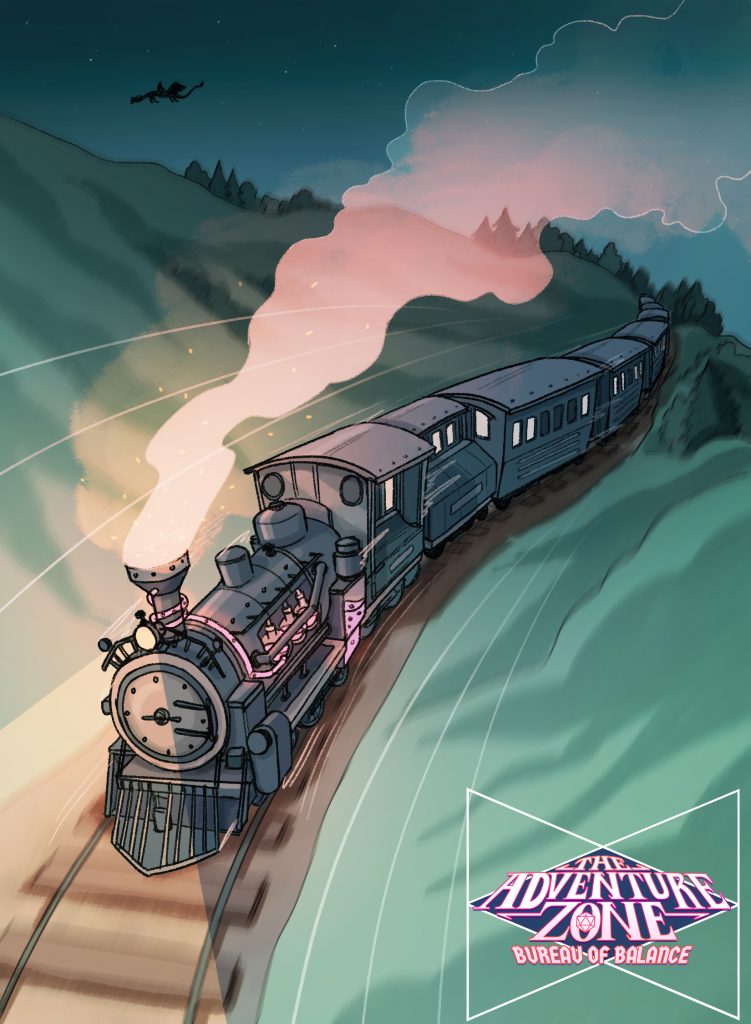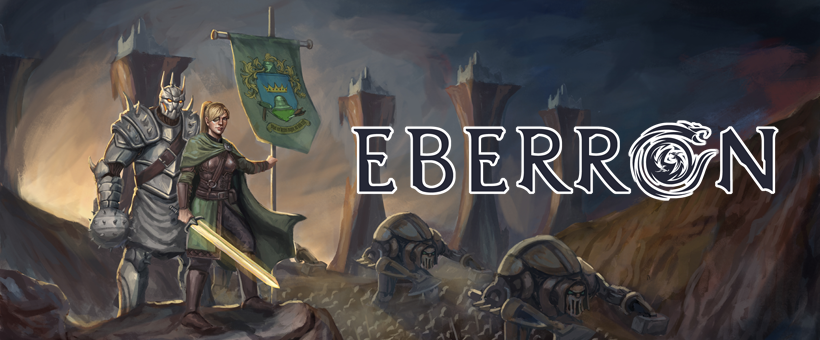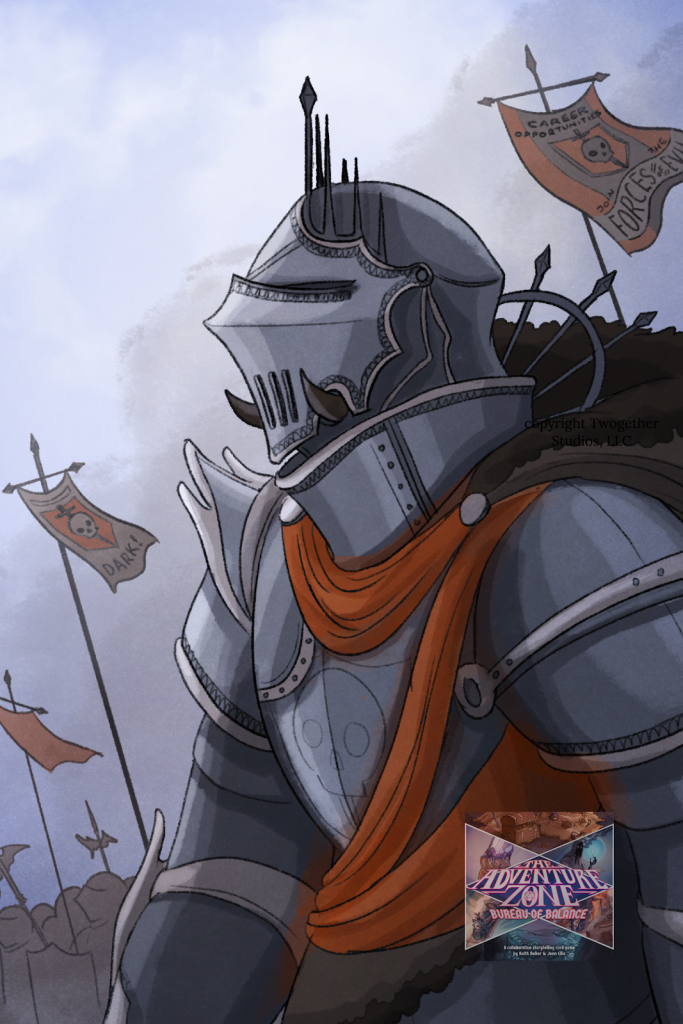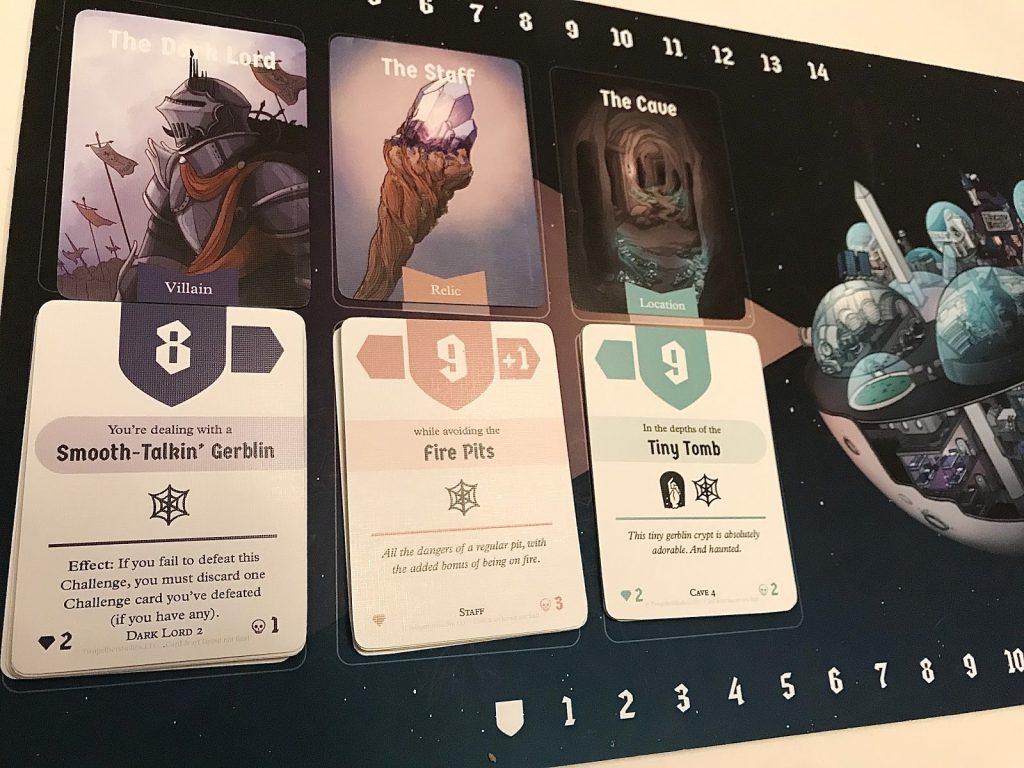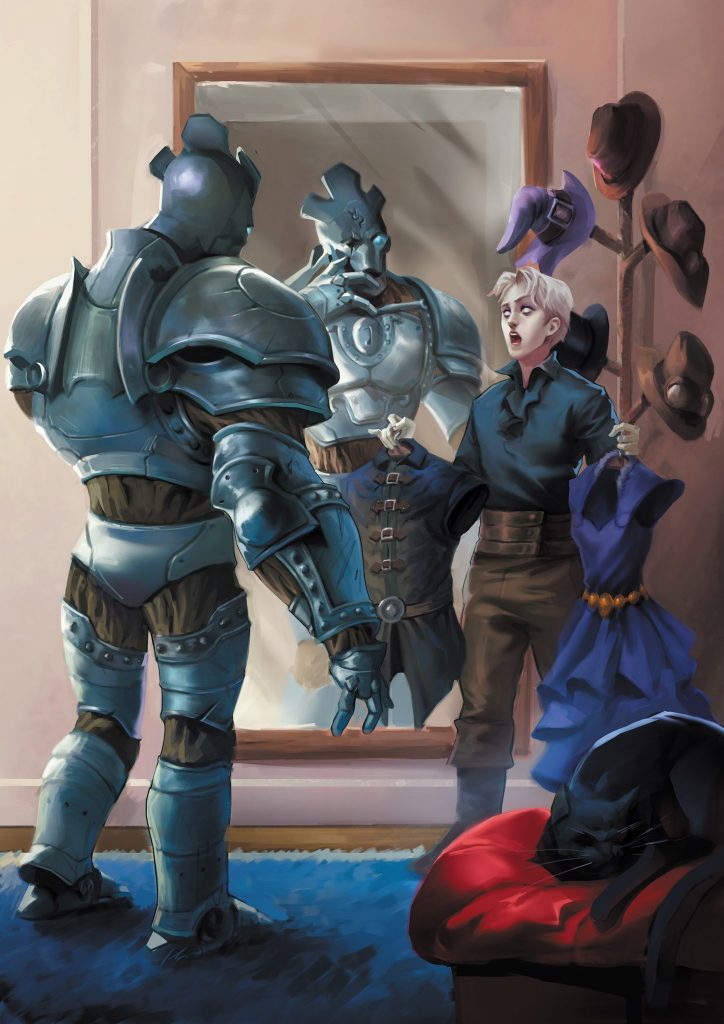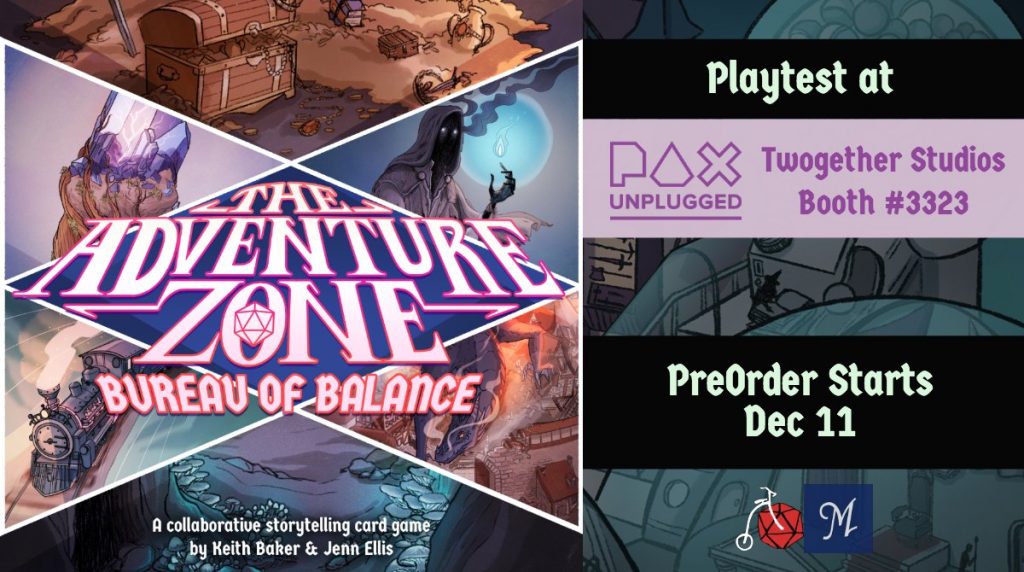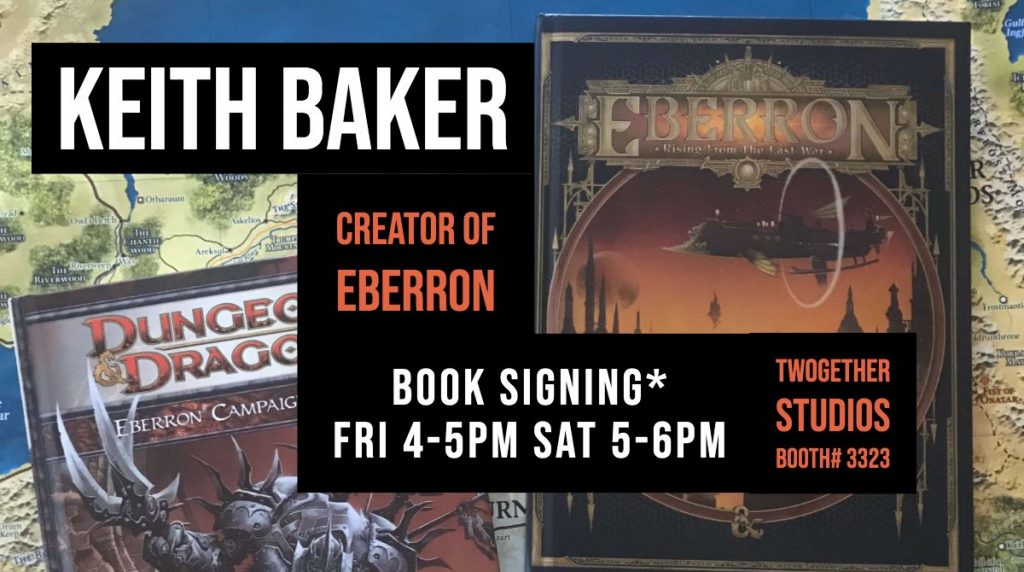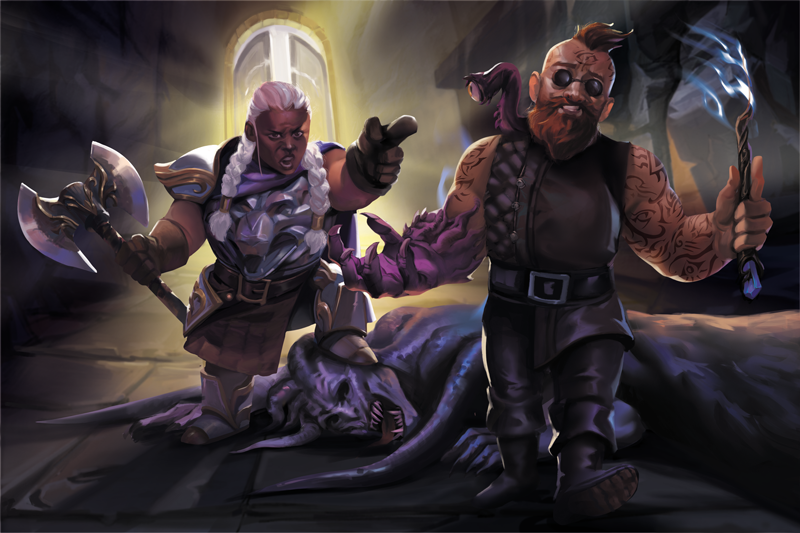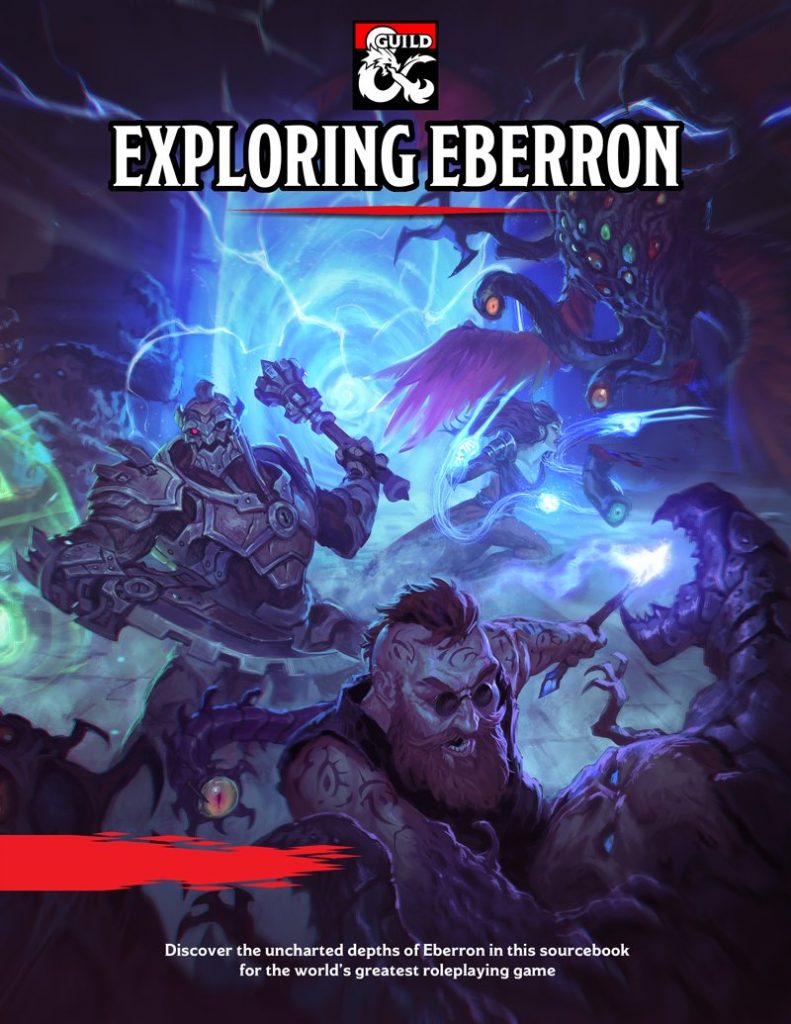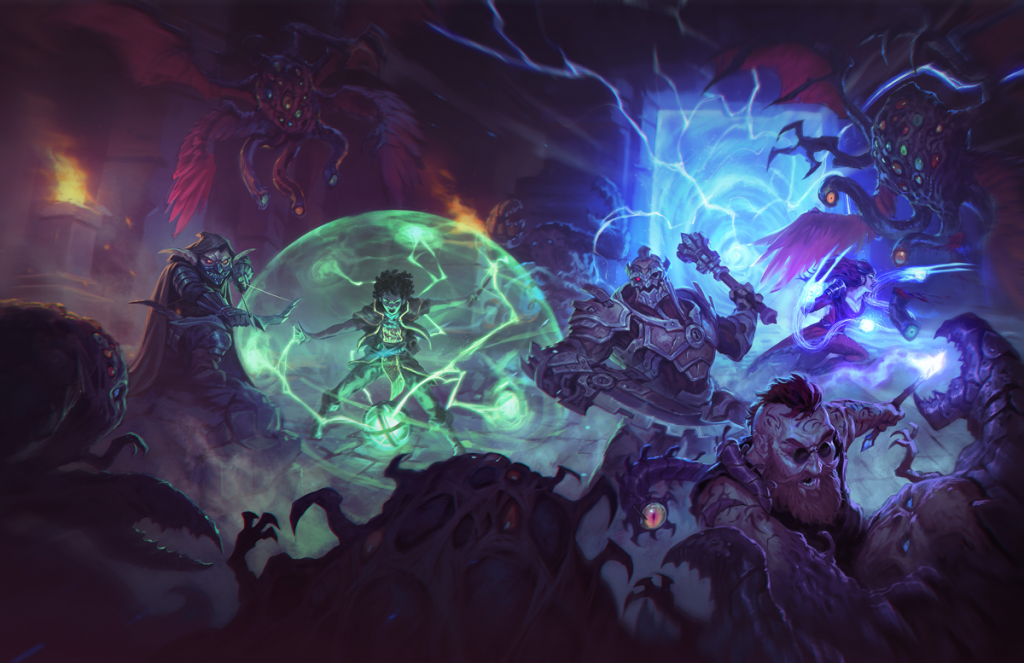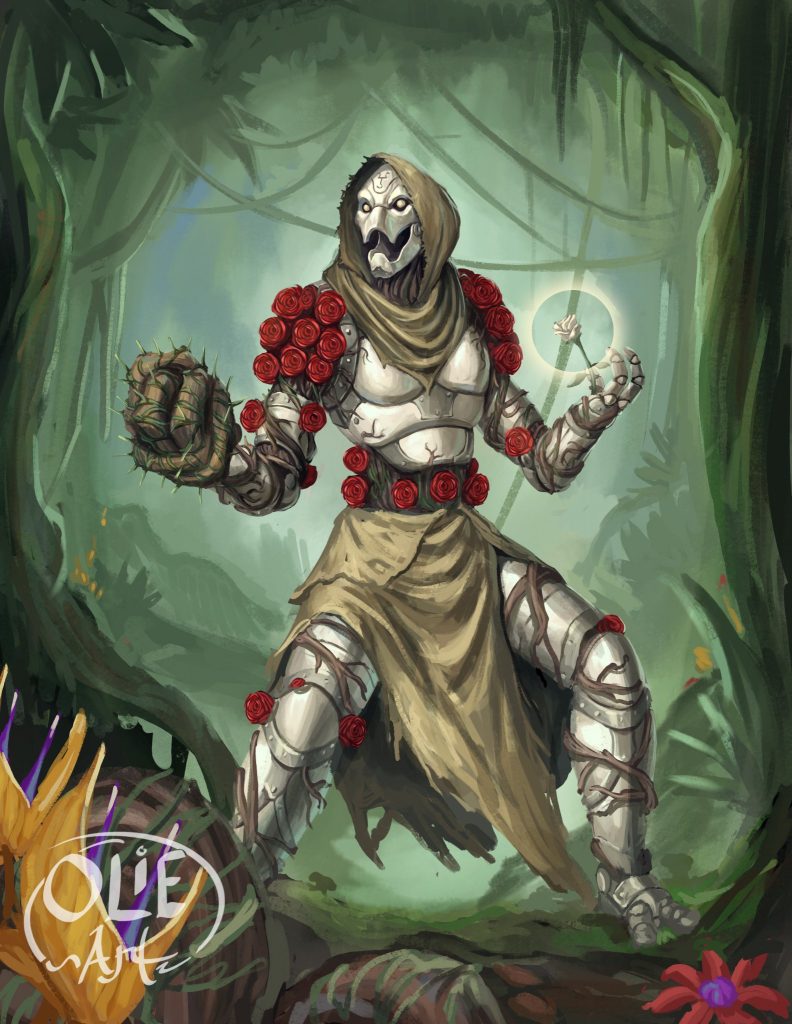This is a time to think of all the things we’ve thankful for, and I for one am thankful that I haven’t been replaced by a changeling. So it seems like a good time to address a few of the questions I’ve received about changelings, the shapeshifters of Rising From The Last War.
First, let’s take a quick look at the foundation of the changeling:
As an action, you can change your appearance and your voice. You determine the specifics of the changes, including your coloration, hair length, and sex. You can also adjust your height and weight, but not so much that your size changes. You can make yourself appear as a member of another race, though none of your game statistics change. You can’t duplicate the appearance of a creature you’ve never seen, and you must adopt a form that has the same basic arrangement of limbs that you have. Your clothing and equipment aren’t changed by this trait. You stay in the new form until you use an action to revert to your true form or until you die.
A question that comes up quite often is given the threat posed by changelings impersonating people, what steps do Eberron’s factions and governments take to deal with them?
The everyday magic that drives the civilization of Khorvaire only goes up to around 3rd level. So you don’t have guards stationed with true seeing at every important location. Which is good, because from a metagame perspective, changelings should be able to fool people. That’s the point of playing a changeling. We don’t muzzle dragonborn to keep them from using their breath weapons or make wood elves wear cement boots to negate their extra movement. If you play a changeling, you should be able to fool people.
With that said, that doesn’t mean it should be EASY. The people of Khorvaire are very aware of the existence of changelings, and after centuries of coexistence have a very good idea of their capabilities. So let’s consider those for a moment.
- As a changeling it is assumed that you can perfectly replicate the appearance of a creature you’ve seen before (just like someone using disguise self). No roll is required to duplicate basic physical appearance.
- However, this doesn’t provide you with any knowledge of that person and their quirks. It’s taken for granted that you sound like them—the voice comes with the shape—but you don’t know their mannerisms or their vocabulary.
- Likewise, the most crucial limitation on changelings is that clothing and equipment don’t change. You can look like a guard, but you don’t get the uniform for free.
So: People of Khorvaire know there are people out there that can duplicate their appearance… but that they can’t steal their memories or copy their belongings. One immediate impact of this is that people make a conscious effort to develop unique mannerisms and accessories. People establish in-jokes and call-and-response phrases. They will often have at least one unique, personal accessory—a piece of clothing, jewelery, even a pet—that they carry all the time as an identifying factor. In part, this is simply about developing a personal style; but in Eberron, it also has the absolute concrete underlay that “If you see me without this accessory, you should be suspicious.’
So in my case, I have a hat that I wear all the time. Everyone knows me by that hat. If I every show up without the hat, my friends will notice. They won’t automatically assume that I’m an imposter, but they WILL probably try out one of our shared jokes or stories and see if I respond to it. This same basic principle applies to institutions. Guards will have distinctive uniforms. They will have SOME sort of ID object—whether it’s identification papers, a brooch of rank—that will stand out if it’s absent. And they WILL have a system of passwords or phrases that they use to test people suspected of being imposters. Because after all, changelings aren’t the only threat; anyone can get a hat of disguise. In a high security location, this system could have more layers to further confuse people. The ID item could change regularly. Imagine an ID brooch that’s a common magic item, enchanted so you can change its color by touching it and saying a command word. The appropriate color could vary based on the current time and day of the week. So an imposter with disguise self could duplicate the appearance of the uniform; but if they don’t know the system, they won’t know what color their brooch should be.
While this isn’t foolproof, these sorts of systems can make it very difficult for a changeling to fool people. However, this is where DECEPTION comes into play. You don’t have to make a skill check to duplicate someone’s appearance. You have to make a skill check when you do something that makes them suspicious… and if you are successful, it means you’ve managed to allay their suspicions. If you duplicate my appearance and don’t have my hat, a successful Deception check means you’ve recognized that people are suspicious and done SOMETHING to convince them that nothing’s wrong. Perhaps you make an excuse about what happened to the hat. Perhaps you never even know the hat is the issue, but you’re just so skilled at putting people at ease that they forget about the hat. It’s the same principle with a password or an ID badge. The fact that you don’t know the password doesn’t mean that it’s impossible for you to get past a guard; an excellent Deception check means you’re able to convince them there’s a good reason you don’t have the password, or to otherwise get them to ignore it. On the other hand, there can also be inanimate security systems that can’t be fooled. An alarm could be tied to that common magic ID badge; if you enter the chamber without one, it will trigger the alarm. Which means you CAN still pull off this job; but you are going to have to somehow get one of those badges to do it.
In general, if you’re playing a changeling bard with expertise in Deception, you are SUPPOSED to be a master deceiver. You SHOULD be able to fool people. On the other hand, you’re not going to be able to simply walk into the Kundarak vault and steal all the treasure because you’re wearing someone’s face. They will have passphrases, and they will use magic that’s available (up to 3rd level); so you will have alarm, and in the case of a Kundarak vault you might even be questioned under a zone of truth. People KNOW changelings are around. They are PREPARED. But it’s always possible to overcome these with enough work and preparation.
One key point to bear in mind is that an easy way to not get caught is to not impersonate someone in the first place. The whole idea of a persona is that changelings will CREATE unique identities for their purposes. If a family of changelings created the identity of “Keith Baker,” they’re the ones who came up with the hat in the first place; they KNOW all the recognizable quirks of the character. The traveling changelings often don’t duplicate the appearance of outsiders; they simply use the persona best suited to the situation.
Another question that’s come up is can a changeling impersonate a warforged? This ties to a second question, can a changeling appear to be wearing a mask, but it’s actually just their face?
The answer to both of these hinges on the phrase your clothing and equipment aren’t changed by this trait. A mask is a piece of equipment, so no, you can’t make a fake mask. Likewise, you can duplicate the appearance of a warforged, but you can’t replicate armor—and most warforged are always wearing armor. So you could be a “naked’ warforged, which means you’ve just got the livewood musculature exposed, but that’s not normal for warforged and you’ll draw a lot of attention.
If a Changeling transformed into someone/thing with webbed hands and feet, or claws, would they have any benefit, even if it’s not a lot?
No. A changeling gains no mechanical benefit from their disguise. As suggested in the comments, I could imagine granting a Stealth bonus to a naked changeling who wants to shift the color of their skin to hide in a snowbank, but the key points there are “naked” and “snowbank” (IE, not a complex background). A changeling can make it LOOK like they have sharper teeth or claws, but this doesn’t actually give them natural weapons; it’s a deception. Essentially, it is a form of disguise self, NOT alter self.
Having said that, Exploring Eberron will have a few options that allow changelings to improve their natural shapeshifting abilities in order to get mechanical benefits from it.
Could a particularly skilled Changeling pull off a Cuttlefish impression?
No; the ability states “you must adopt a form that has the same basic arrangement of limbs that you have.” With that said, I have in the past suggested the idea of a Changeling Menagerie—a changeling who is mechanically a Circle of the Moon druid, but who explains their class features as being derived from their mastery of shapeshifting as opposed to druidic traditions.
I’d love to know more about Changeling Culture. I do have a question, and it might be addressed in your book already, but here it is: In your Eberron, how would Changelings view love and romance? Would they stick with their persona the entire time they’re with their significant other, or show their true nature once they decide to commit to each other?
Exploring Eberron does go into more detail about changeling cultures, and the key point is that this isn’t a simple answer because there’s more than one changeling culture and the common answer (as there’s always exceptions in love!) would definitely vary by culture.
- Stable changelings live openly as changelings and wouldn’t need to hide their true nature in the first place. I’d expect them to use personas as part of courting, but not to deceive the lover—rather to show them all the different facets of the changeling’s personality, to explore all the possibilities of their relationship. This could be confusing for a non-changeling lover, but between changelings it would be an important part of learning about one another. A final aspect of this could be developing an entirely new persona that is used ONLY with the lover: this is who I am with YOU.
- Passers—lone changelings blending into non-changeling communities—might chose to share their true nature with a lover because they want to be completely honest with them. But there are passers who deny their own changeling nature and consider their chosen persona to BE their true identity; so they might believe they are BEING honest in using the persona. But part of the point is that passers aren’t really a culture; each one deals with unique circumstances.
- Where the static changeling might create personas to show their facets to a lover, for the traveling changelings personas are important tools and stories. Many personas are shared, and any change you make to the core story of the persona would have to be followed by anyone else using the persona. If Tel-as-Bronson takes Jesse as a lover as Bronson and their cousin Dal also uses Bronson, then it’s Dal’s job to love Jesse when they are Bronson. So essentially, the question is are you taking this lover yourself—in which case, once you are certain about the relationship, you would DEFINITELY want them to know your true face—or is the persona taking this lover—in which case you’d never want to let them see your true face. This doesn’t mean the persona-lover would be any less intense or real; but it’s not part of YOUR story, it’s THEIR romance.
And these are just three of the more prevalent changeling cultures. So there’s a lot of possibilities.
I would think changelings must have some kind of internal law system for dealing with malcontents.
Remember that just like elves or for that matter drow, “changelings” don’t have anything as a whole. They aren’t a monolithic force; they have different cultures, and each culture will have their own traditions. With that said, yes, there would definitely be punishments for those whose actions threaten the community. Also bear in mind that theft of identity is a crime under the Code of Galifar; obviously casual actions can be hard to prove, but it’s an issue a changeling had best be aware of if they are going to be going before the law of the Five Nations.
One of the simplest but most severe punishments would be an indelible mark—a magical tattoo that cannot be removed by shapeshifting. The technique of the indelible mark is a secret held close by the elders of the Children of Jes, used only in severe situations. An equally severe punishment for serious offenses is removal of all or part of a limb; as noted above, changelings can’t create limbs with their power. With both of these punishments, the message is simple: if you abuse your gift, it can be taken from you. A lesser punishment would be the destruction of the criminal’s personal personas (through other changelings adopting the person and taking actions that can’t be undone).
Do changelings sometimes use their shapechanging artistically or outlandishly? Wild hair colors, patterned skin, strange eyes?
This is a question of culture. In stable changeling communities where they live openly as changelings, they absolutely use shapeshifting artistically and as a form of expression. The Queen of Stone has a changeling dancer changing patterns on their skin as part of the performance. Page 18 of Rising From The Last War notes that changeling names often incorporate a minor degree of cosmetic shapeshifting—Jin-with-vivid-blue-eyes. Traveling changelings and passers hiding their changeling nature obviously won’t use shapeshifting in this way, but still use it subtly to convey messages to family members.
Can all changelings get pregnant? Are they biologically asexual and just choose their current sex with shapeshifting?
Yes. What’s been stated in the past is that changelings set their sex with shapeshifting. Prior canon has said that a pregnant changeling actually loses the ability to shapeshift during the pregnancy. This seems extreme to me, but I could see the idea that they need to maintain a female form in order to maintain the pregnancy (and that shifting form very early in the pregnancy would simply end it, so changelings have a very easy form of birth control). The idea that changing sex is an instinctual thing, like flipping a light switch, and that a normal changeling couldn’t, for example, assume a male form but keep the uterus. With that said, if you had a changeling called out as having greater control over their abilities (for example, the Changeling Menagerie druid I’ve mentioned elsewhere) I might allow that.
Can changelings mate with non-changelings, and are their children full-blooded changelings?
What we’ve said before is that changelings can mate with most humanoids; if the child is born to a changeling mother they’ll be a changeling, while if the mother is another species there’s a 50/50% chance for either species. A changeling child is born with the apparent species of their mother, and the shapeshifting ability doesn’t set in for around a year. This is the origin of the name “changeling” — because when someone’s previously human child suddenly becomes a pale thing, it was once thought that the original child had been taken to Thelanis.
Having said that: while changelings CAN mate with other humanoids, I’d say that it is RARE for them to impregnate creatures of other species. It can happen, but the fertility rate isn’t that high. It’s quite possible that humans and other human-compatible species are the most viable. With that said…
Are changelings biologically compatible with other changelings or are they parasitic with humanoids?
Changelings are biologically compatible with changelings. Most changeling cultures are relatively insular, precisely because many traditions of the culture are tied to shapeshifting and a fluid outlook on identity, and it’s difficult to integrate a single-skin into the community. There certainly are changelings who choose to pursue relationships with members of other species —see the changeling romance answer above—but it’s not the common practice.
Can they disguise injuries, like if a guard cut your face and you escaped but they try to track you by the cut?
It would depend on the extent of the injury. There is no mechanical benefit to changeling shapeshifting, so they can’t actually heal themselves. However, I’d personally say that they can conceal minor injuries. If it’s a specific story point—an especially grievous wound inflicted for the express purpose of marking the changeling—I’d probably have the changeling make a Wisdom (Medicine) check to simply seal the wound. If they failed that, I’d still likely let them minimize and conceal it, but if someone was explicitly looking for an injured changeling it would be grounds for requiring a Charisma (Deception) check to conceal it.
What if you cut off a changeling’s arm?
Changeling shapeshifting provides no mechanical benefit, and as a changeling “you must adopt a form that has the same basic arrangement of limbs that you have.” The ability to regrow a lost limb would certainly be a mechanical benefit. So as noted above, this is a particular brutal form of justice in a changeling community.
Can changelings fake convincing dragonmarks? Can changelings be tattooed?
Yes and yes. A changeling can duplicate the appearance of a creature they’ve seen; there’s no exception stating “unless that creature has a dragonmark.” With that said, dragonmarks glow when used; if the character is attempting to make it appear functional, I’d definitely require a Charisma (Deception) check, and for them to have seen the mark used before. And note that this sort of fake dragonmark won’t let you use a dragonmark focus item.
As for being tattooed, changelings can definitely be tattooed, and they can just as easily erase the tattoo with a moment’s thought. As mentioned above, the Children of Jes have a curse known as the indelible mark which can only be removed using a spell that would remove a curse, but a mundane tattoo can be easily faked or removed.
What’s up with doppelgangers? We know changelings believe they’re a kind of insane changeling, but how true is that if doppelgangers seem to come from Khyber?
Under 5E lore, doppelgangers are changelings twisted by the daelkyr Dyrrn the Corruptor. A general belief is that this change is actually primarily psychological. Doppelgangers have a fundamentally alien outlook. They are predators who so paranoia and chaos when not working for a specific Cult of the Dragon Below, but there’s often no apparent motive for their actions. This is largely about the horror of a creature who knows your thoughts, who can kill you with its bare hands and steal your face, but that you don’t know WHY or what it wants.
One possibility is that doppelgangers are biologically distinct from changelings. Another possibility is that they are physically identical, and that the doppelganger’s superior abilities are simply unlocked by its alien psychology. With this said, it’s possible that changelings can also unlock these same abilities—but that in so doing they will lose their original personality and become doppelgangers.
Would a scholar be able to tell the difference between a changeling and a doppelganger? Would a changeling be able to recognize a doppelganger if they saw it using its abilities?
In their natural forms, doppelgangers and changelings are quite different. Just take a look at the picture in the Monster Manual! Doppelgangers are hairless and less human in their proportions. If you embrace the idea of the changeling becoming a doppelganger, once it underwent the psychological transition its “true form” would change to match the hairless doppelganger form.
With that said, a changeling could DISGUISE itself as a doppelganger (if it had see one in its true form), and vice versa!
As for recognizing it, the BASIC shapeshifting action is identical. You don’t see someone shift faces and say “That’s not a changeling, it’s a doppelganger!” You recognize it by its ability to read thoughts and by its deadly unarmed attack.
Does the 2nd level Moonbeam work against changelings? If so, wouldn’t this have large implications in the viability of hiding as a changeling? Likewise, are changelings immune to the polymorph spell, which fails when used on shapeshifters?
WotC has confirmed that changelings are considered to have the Shapechanger subtype. So they are indeed immune to polymorph and can be affected by moonbeam.
With that said: Moonbeam isn’t a particularly effective changeling test. It’s a 2nd level spell, so it is in the world, but that’s still not something people use all the time. It’s also a druid spell, and druidic magic isn’t common in the Five Nations. Most important, it inflicts 2d10 radiant damage, which is MORE than enough to kill a normal person. So using moonbeam to check if someone’s a changeling is like shooting them in the face to see if they’re a vampire.
To what degree are 4th (Private Sanctum), 5th (Geas), and 6th (Forbiddence) level spells available to high end buyers (eg Royalty). I know the 3.5 Dreadhold write up had antimagic, which is 8th level, but I don’t have a sense to grade from “Standard enclave” to “The most impenetrable prison of all time”. I know greater marks go up to 5th, but are 5th level spells that aren’t on a Spells of the Mark list available for the ultrawealthy?
This isn’t strictly a changeling question, but it ties to the general topic of detection. First of all: one of the general principles of Eberron is that only magic of up to 3rd level is commonly available — employed by magewrights, etc. This article discusses a range of options that fall under that umbrella, based on alarm, glyph of warding, and arcane lock.
Spells of 4th level and above can be available, but they are rare and expensive—not services you should take for granted. The Spells of the Mark tables are good guidelines but are NOT complete. These are spells heirs may be able to CAST, but the direct powers of a mark are not as important as the ability to use focus items – and for example, I have a focus item in Exploring Eberron that allows a dwarf with the mark of warding to cast guards & wards. Effects such as forbiddance and true seeing are POSSIBLE, but they should be RARE, not something anyone would take for granted. It’s the sort of thing where a commoner might have HEARD of a Kundarak houseward but never seen one.
Meanwhile, Dreadhold is the most secure prison in Khorvaire. It is LEGENDARY. Yes, it employs forbiddance and antimagic—but that doesn’t mean you should find these effects in a typical city jail.
Doesn’t the Shapechanger ability of the changeling invalidate the 9th level Infiltration Expertise and 13th level Imposter ability of the Assassin rogue? Isn’t that too powerful? I assume that a changeling should get advantage on Deception checks because of its disguise, but that’s what Imposter does.
I don’t see the conflict between these abilities. ANYONE can get the ability to change their appearance as a changeling does. Disguise self is a 1st level spell and the hat of disguise is an uncommon magic item, and both of these are BETTER than the changeling’s Shapechanger power because they allow the user to change the appearance of their equipment and clothing. It’s been called out in the past that hats of disguise are standard issue for elite members of the Royal Eyes of Aundair; if this uncommon item entirely negated the 9/13 abilities of the assassin, it would be pretty sad for the assassin.
The 9th level Infiltration Expertise ability allows you to “establish the history, profession, and affiliations for an identity… For example, you might acquire appropriate clothing, letters of introduction, and official-looking certification…” The changeling Shapechanger ability doesn’t give you ANY of these things, specifically NOT letting you change your clothing. Infiltration Expertise is the perfect tool for a changeling who wants to create a new persona. The Shapechanger ability changes their face, but Infiltration Expertise creates an IDENTITY that will hold up if the disguise is questioned.
Meanwhile, the basic idea of the Shapechanger ability—like the hat of disguise or disguise self—is that the disguise is PHYSICALLY perfect, but that the changeling will have to make a Deception check if there’s reason for someone to be suspicious. Imposter gives a changeling—or an assassin using a hat of disguise—advantage on any Deception check, which is extremely useful.
A key point here: You suggest “The implication to me would be that a Changeling would have an advantage on deception for casual disguises.” I disagree. The disguise itself is physically perfect and requires no roll (again, like disguise self and hat of disguise). If there is a reason that the disguise would be questioned—they run into a close friend of the person they’re impersonating, they don’t know a password or have an important identifying object—they have to make a Deception check. They don’t inherently get advantage because of the disguise; they are MAKING the check because the disguise is being questioned. To get advantage they’d have to have something else that shifted the odds in their favor — they’d done extensive research, someone provides a distraction, or they’re an expert assassin with the Imposter ability.
So in short, being a changeling is like having a hat of disguise that doesn’t affect your clothing. It lets you change your personal appearance, nothing more. If the disguise is questioned you have to make a Deception check. If you have the Imposter feature you get advantage on this check; and if you have Infiltration Expertise, you ALSO have the proper clothing, identification, and background connections for the role… which reduces the chance that your appearance will BE questioned in the first place.
I’ll be writing more about changeling culture in my upcoming book Exploring Eberron. In my next post I’ll talk about my plans for PAX Unplugged and The Adventure Zone: Bureau of Balance!
And thanks as always to my Patreon supporters! I hope to do more with the site in the future, and support will help determine what’s possible.
If you have questions or thoughts about changelings, post them below!
